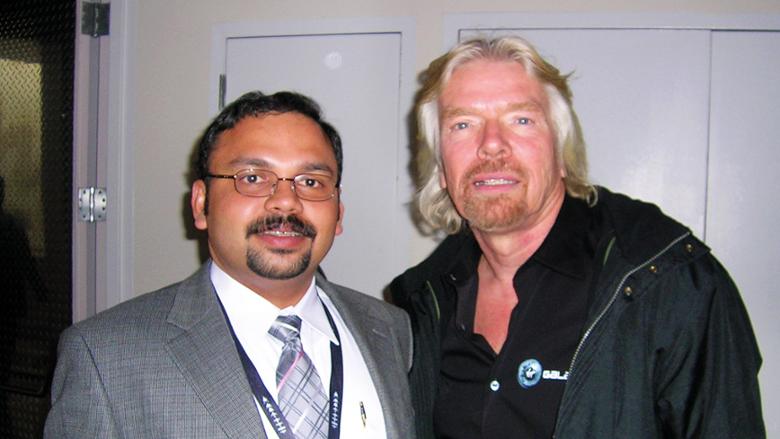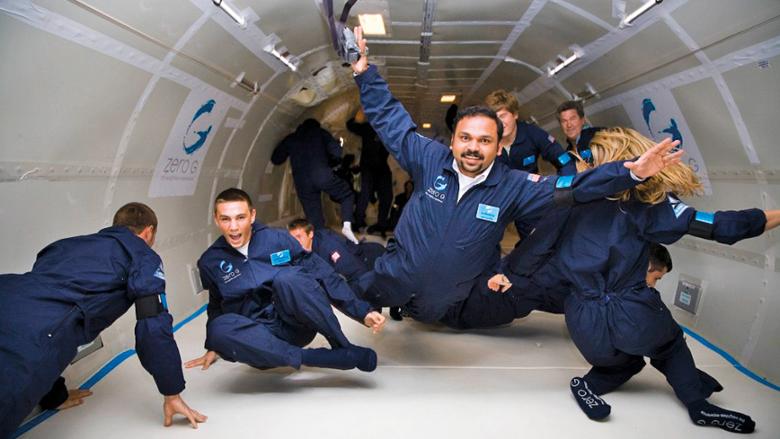On the Safari trail with Santhosh George Kulangara
Santhosh George Kulangara, whose hugely popular Malayalam TV channel Safari hosts highly praised edutainment programmes including his travelogues, tells Varsha Jayaprasad about the more than 130 countries he visited, his escapades during his travels and why everyone should travel
When it comes to getting a seat upgrade on an aircraft, few can beat what Santhosh George Kulangara ended up with while on a flight from Pokhara to Kathmandu way back in 1997.
In his mid-20s at the time, the Keralite, a 10kg U-Matic camera set slung across his shoulder, was visiting Nepal, the first stop on his one-man-produced travelogue. Hoping to secure a window seat so he could shoot some footage of the mountains from the air, he requested the air-hostess if she could help him.
“Give me a few minutes,” she said, before heading into the cockpit.
Even as Santhosh was wondering whether he would get his choice of seat, the air-hostess returned to tell him that the pilot wanted to meet him.
“To be honest, I was surprised and a tad puzzled,” says the now 50-year old author, travel journalist and passionate tourist, during an exclusive interview with Friday on the sidelines of the Sharjah International Book Fair (SIBF) where he was a speaker. “I wondered whether I was in some sort of trouble because of my camera.”
Although nervous and apprehensive, he followed the cabin crew into the cockpit only to be warmly greeted by the pilot, who asked him what he was doing in Nepal. Santhosh explained that he was shooting a travelogue ‘for my people back in Kerala, India’ and that Nepal was the first place on his to-visit list but unfortunately, he couldn’t get a window seat.
“Unbelievably, the pilot offered me a seat in the cockpit,” says Santhosh, who now heads the hugely popular and respected Malayalam TV channel Safari. “That was not all. The pilot was so kind and actually acted as a guide, pointing out prominent sights such as some famous temples and major tourist destinations from the air. When they missed shooting any spots, the pilot would tell the co-pilot to swerve around a bit and tip the plane slightly so I could capture some good footage.”
At the end of the flight, the pilot requested that he pose for a picture with him before saying, “You have a great idea of making travelogues; I am sure they will become popular. I want a picture with you so someday I can show it and tell people your first travel was with me.”
The pilot’s words would be prophetic. Over the past more than two decades, Santhosh has visited and chronicled more than 130 countries. The critically acclaimed and hugely popular video travelogues – the first in Malayalam language – have been telecast and are a part of Sancharam (Travel) available on the Safari YouTube channel and website.
The beginning
Santhosh, who hails from Kottayam district in southern Indian state of Kerala, is convinced that a passion for travel runs in his genes. His father used to run a private college and would regularly take his students to various states across India. “The best thing was that we – the family – got to accompany him and his student,” says Santhosh, who was a speaker late last year at the SIBF. “That was where my first travels started.”
If parents of some of his friends considered travel a waste of time, Santhosh’s parents were in favour of getting their kids experience the world first hand. “Seeing my parents’ open-minded views to travel gave me the confidence to give wings to my dreams,” he says.

After pursuing media studies in college, Santhosh took his first steps in the world of audio visual journalism by producing programmes for Doordarshan, India’s national TV channel. His telefilm Kerala Vishesham (Stories from Kerala) explored intriguing and underrated areas of Kerala with historical or literary mentions. Thus, thanks to the programme many got a better peek into places such as Kadathanadu, a city on the Malabar Coast famous for its events in Vadakkan Pattukal (Ballads of North Malabar) and Lokanarkavu, a temple in Kozhikode District which is referred to in several literary and historical texts.
Bursting with ideas, he began pitching more programmes but frustrated by the delay it took in commissioning productions he decided to take things into this own hand. Seeking inspiration from some travelogue books by S. K. Pottekkatt, he conceived of a programme that would tell stories of places in and around India – a visual travelogue that would edutain viewers. “That was the start of Sancharam,” he says.
Travel memories and scrambles
If his first trip was to Nepal, Santhosh would go on to visit Siberia, Fiji, Niagara and over 130 more countries to create insightful programmes that detail the history, geography, culture, people and food of each of these places.
“Initially, carrying the 10kg camera was literally a pain,” he says. “If I came across a new camera that was 500 grams lighter than the last one, I did not hesitate in buying it.”
He recalls an incident that occurred with his camera when he was travelling in Europe.
After a long night train, Santhosh reached Zurich railway station. “I used to travel during the nights to save time and also the money I might have to spend taking a room in a hotel,” recalls Santhosh. Reaching the Zurich station during the early hours of the day, Santhosh needed to use the restroom. Unable to spot a security guard or anyone reliable to look after his equipment while he used the restroom, Santhosh was forced to take them all with him into the stall. The tiny European restroom cubicle did not make his situation any better. Laughing as he recalls the memory he says how he “had to balance the equipment on my head while I used the restroom”.
Looking back, the father of two admits that travelling has changed drastically over the years. “Booking a hotel room isn’t the same as it was back then. Now we have the luxury of knowing how your room will look, back then you got to see the state of the room when you got to the hotel,” he says. And very often, the premises would be far from what he had expected.
Communication, an issue
Santhosh talks about an experience in Rio De Janeiro, Brazil where he was trying to explain to a taxi driver that he wanted to see the Christ the Redeemer statue. “Unfortunately, I forgot the name of the statue and was struggling to explain to the taxi driver where I wanted to go. Finally I stood up and stretched my arms, and the taxi driver immediately understood where I wanted to head to.”
A similar experience occurred in Seoul, Korea, where he wished to visit the Namsan Tower in Seoul. “Because of the language barrier, I was struggling trying to explain to the taxi driver the place I wanted to visit before an idea came to mind.” Fishing out a piece of paper he drew a figure resembling the Namsan Tower, “instantly the taxi driver knew the place I was asking him to go”, he says, with a laugh.
Apart from language, did he have any adventures when it came to foods?
“Oh yes, there have been moments when I have tasted some foods that were truly novel to me,” he says.
He recalls a trip to Beijing, China, when he visited a small street food joint run by a family. Not shy of trying out new cultures or tastes, Santhosh asked the chef to prepare a dish of river snails. I quite liked the dish and seeing me enjoying my meal, the family welcomed me into their home,” says Santhosh. “Regardless of the language barrier, the owner and his family were just happy to see me enjoy their food.”
Dream destination
Is there any country or city he was keen to visit ever since he laced up his travel boots?
“Tibet,” he says. “That was a place I was always curious about. Growing up learning about the Dalai Lama, the Potara Palace and the culture fascinated me. I’ve been wanting to visit the place since I started doing this program.” The dream would come true in 2017-2018.
Travelling, says the intrepid explorer, is something everyone should indulge in. “It can give you a better perspective of the world. When you travel, you learn. The more you travel, the more you will learn.”
First tourist in space
“It was never my dream to go to space. It was always my dream to travel,” says the globetrotter as he narrates the story of how he signed up for the Virgin Galactic space tourism initiative.
While on a train ride from Lancaster to Glasgow, he came across a few newspapers on the seat across him. Glancing through the pages and saw a piece that said Virgin Atlantic was open to taking tourists to space. The post caught the explorer’s eye and Santhosh dashed off an email to Virgin Atlantic expressing his interest in traveling to space. Within a couple of months, the UK branch of Virgin Galactic called him. “Do you want to be the next space tourist?” they asked. ‘I did not have any hesitation in saying yes,’’ he recalls.
After a series of terms and conditions and detailed documentation, the aspiring space tourist signed the contract to travel to outer space. As part of the training program by Virgin Galactic, Santosh underwent Zero Gravity and Gravity Tolerance sessions, and also got the opportunity to meet with business tycoon, Richard Branson.
“It is exciting to be a part of such a mission and take part in thrilling activities with many other individuals and also have the opportunity to meet and dine with Richard Branson twice a year. Yet, it is the sheer experience of it all that will remain as a primary highlight of the whole activity” says the voyager. The training is still ongoing, and Santhosh hopes to go to space soon.
A note to aspiring travellers and travel bloggers
Although travel blogging has grown exponentially on social media and other platforms, Santhosh makes it clear that travel blogging and travel production are not the same. “Travel blogging focuses solely on the choice of the viewer, and therefore the blogger shows the viewers what they ask for. Whereas, a visual travelogue is to teach and make the viewers aware of what they aren’t aware of.
“It is to identify your travel motive, find your location, and explore it out of the ordinary.” The traveller emphasizes that it is important to do extensive research on the place to be able to offer an entirely complete experience. “I focus on history, socio-political issues, and significance of the place while creating the programme, therefore one should identify the focus of their travel and document concerning that angle,” says Santhosh.

